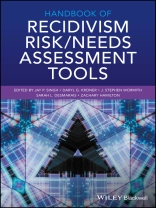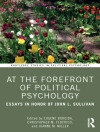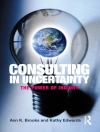Provides comprehensive coverage on recidivism risk/needs assessment tools
Correctional and healthcare professionals around the world utilize structured instruments referred to as risk/needs assessment tools to predict the likelihood that an offender will recidivate. Such tools have been found to provide accurate and reliable evaluations and are widely used to assess, manage, and monitor offenders both institutionally as well as in the community. By identifying offenders in need of different levels of intervention, examining causal risk factors, and individualizing case management plans, risk/needs assessment tools have proven invaluable in addressing the public health issue of recidivism. Recidivism Risk/Needs Assessment Tools brings together the developers of the most commonly-used risk/needs assessment tools to provide a comprehensive overview of their development, peer-reviewed research literature, and practical application.
Written by the leading professionals in the field of risk/needs assessment, the book provides chapters on: Recidivism Risk Assessment in the 21st Century; Performance of Recidivism Risk Assessment Instruments in Correctional Settings; Correctional Offender Management Profiles for Alternative Sanctions (COMPAS); the Federal Post-Conviction Risk Assessment Instrument; the Inventory of Offender Risks, Needs, and Strengths (IORNS); the Level of Service (LS) Instruments; the Ohio Risk Assessment System (ORAS); the Self-Appraisal Questionnaire (SAQ); the Service Planning Instrument (SPIn); the Static Risk Offender Needs Guide-Revised (STRONG-R); the Offender Group Reconviction Scale (OGRS); the Forensic Operationalized Therapy/Risk Evaluation System (FOTRES); the Ris Canvi; and more.
* Systematically identifies currently-validated recidivism risk/needs assessment tools
* Reviews research on recidivism risk/needs assessment tools used internationally
* Each chapter presents sufficient detail to decide whether a given recidivism risk/needs assessment tool is right for your practice
Recidivism Risk/Needs Assessment Tools is ideal for correctional, probation and parole, and behavioral health professionals.
Mục lục
1 Introduction Preface: Recidivism Risk Assessment in the 21st Century
2 Performance of Recidivism Risk Assessment Instruments in Correctional Settings
3 Risk/Needs Assessment in North America The CAIS/JAIS Approach to Assessment
4 Correctional Offender Management Profiles for Alternative Sanctions (COMPAS)
5 The Federal Post-Conviction Risk Assessment Instrument: A Tool for Predicting Recidivism for Offenders on Federal Supervision
6 The Inventory of Offender Risks, Needs, and Strengths (IORNS)
7 The Level of Service (LS) Instruments
8 The Ohio Risk Assessment System
9 Self-Appraisal Questionnaire (SAQ): A Tool for Assessing Violent and Non-Violent Recidivism
10 Service Planning Instrument (SPIn)
11 The Static Risk Offender Needs Guide-Revised (STRONG-R)
12 Risk/Needs Assessment Abroad Offender Group Reconviction Scale
13 Forensic Operationalized Therapy/Risk Evaluation System (FOTRES)
14 The Ris Canvi: A New Tool for Assessing Risk for Violence in Prison and Recidivism
15 Conclusion Risk Assessment: Where Do We Go From Here?
Giới thiệu về tác giả
JAY P. SINGH, Ph D, Ph D, is the Founder of the Global Institute of Forensic Research and is affiliated with the Department of Psychiatry and the Wharton School of Business at the University of Pennsylvania.
DARYL G. KRONER, Ph D, is a Professor at Southern Illinois University and reviewed the effectiveness of offender programs at the Illinois Department of Corrections.
J. STEPHEN WORMITH, Ph D, is a Professor of Psychology at the University of Saskatchewan, and Director of the Centre for Forensic Behavioural Science and Justice Studies.
SARAH L. DESMARAIS, Ph D, is an Associate Professor and Coordinator of the Applied Social and Community Psychology Program at North Carolina State University.
ZACHARY HAMILTON, Ph D, is an Associate Professor of Criminal Justice and Criminology and the Director of the Washington State Institute for Criminal Justice at Washington State University.












